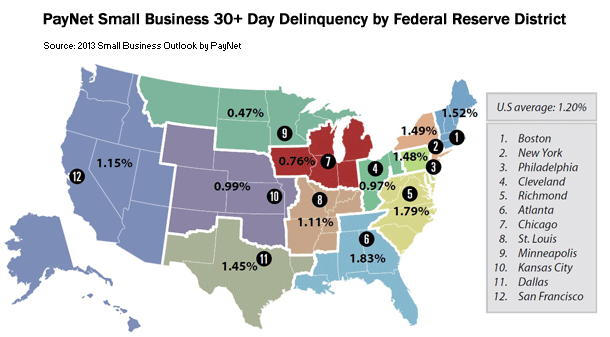
Over the past year, economists have hotly debated reasons why the U.S. economy cannot gain a sense of footing toward stability and consistent growth. And while some correctly predicted the U.S. economy would slow down in the fourth quarter of 2012, which the Bureau of Economic Analysis confirmed as it reported a 0.1% contraction in U.S. Gross Domestic Product (GDP), those that did not, scrambled to explain why this slowdown was in no way a sign of Armageddon in an already fragile recovery.
However, there is one premise most economists would likely agree upon – confidence is a key to economic growth. But gaining a sense of confidence in the U.S. economy is dependent upon many variables, and confidence is often defined differently by consumers, economists, political pundits, large businesses, mid-sized businesses and what many believe to be the lifeblood of the U.S. economy – small businesses. Small businesses' confidence is critical to the overall U.S. economy because small businesses comprise roughly 50% of U.S. GDP.
The economy is improving by most measures, and if you ask the CEOs of the largest U.S. companies, they will likely tell you that times are good – they are flush with cash and profits are growing. The same is not said by small business owners however, and today, small businesses remain cautious as reported in the 2013 Small Business Outlook by PayNet. According to PayNet founder and president William Phelan, small businesses remain cautious, and until these businesses fully participate in the economic recovery, the U.S. economy will continue to experience a slower than normal growth pattern.
“The big thing is getting small businesses to re-engage and start investing again,” explains Phelan. “And the big driver for small businesses is demand for goods and services in the form of sales orders. More demand will spur growth in production capacity, and that will lead to more equipment purchases and job growth in small business. When we look at the data we see that uncertainty really hinders business activity. And uncertainty is extraordinarily hard on small businesses because it hits a small business harder than a large company.”
It’s not all doom and gloom according to Phelan as he sees certain segments currently increasing production capacity. But as a group, Phelan says nearly half of the GDP is not fully participating in the economy; this is why the economy has not fully recovered back to where it was prior to the recession.
The lack of confidence in the recovery was demonstrated in the lackluster growth in the Thomson Reuters/PayNet Small Business Lending Index in 2012. This Index measures the overall volume of financing to small U.S. companies, defined as businesses with $1.0 million of credit or less. According to data, the Index started the year at 110.5 and ended the year at 112, representing a minimal 1.5% increase in investment and borrowing for the year. So what’s holding small businesses back from expanding?
Phelan says that while there’s no definitive answer, he believes the continuing environment of economic uncertainty had a significant negative impact. “There wasn’t a tremendous amount of investment in production capacity and business expansion for these small companies in 2012, especially when you consider the investment and borrowing growth experienced in 2010 and 2011,” says Phelan. “While the 1.5% gain is positive, 2012 demonstrated considerably slower investment than the prior two years. In 2011 the SBLI grew 16% and in 2010 it grew 20%. So there was a marked slowdown in investment and borrowings by small companies.”
The reasons for small businesses holding back on expansion are many, but as Phelan stated, perhaps the better question is: what didn’t hold them back?
“Certainly low interest rates didn’t hold them back; availability of capital didn’t hold them back. The eagerness for lenders to finance equipment did not hold them back. Still, they held themselves back. In the end, businesses love certainty, and they like having a perspective on the future and when you have multiple factors including big policy issues outstanding, it creates uncertainty,” says Phelan.
Small Businesses are True Economic Drivers
According to PayNet’s research, small business investment can have a major impact on the overall economy. PayNet’s data shows the average transaction size for a capital investment by a small business is about $60,000. And on average, small businesses have approximately $350,000 of invested capital.
With this in mind, Phelan explains, “If a small business makes a $100,000 incremental investment of some type, it’s significant because small business owners cannot afford to put $100,000 at stake as they are already operating on thin margins. So, the SBLI demonstrates that small businesses are not willing to make significant capital outlays now.
But if every single one of them undertakes one $60,000 expansion project, that would equate to about $400 billion of added capital pumped into the economy. Our data also demonstrates that every one point increase of the SBLI adds about 42,000 jobs to the economy. So, we can see how small businesses re-engaging and investing can have a big impact on the overall economy.”
But there’s a flip side to the data according to Phelan and that is small businesses are nimble and can ramp up very quickly and make decisions to expand and invest extraordinarily fast in PP&E, tools or even a business unit. But as Phelan puts it, “They are waiting to come out of their shell.”
Geography and Sector Impact
The 2013 Small Business Outlook describes small business credit as in ‘good shape’ in terms of 30+ day delinquency data, with the largest states in the mid-west region in the best shape. However, the data varies by geography as local economies can and do impact delinquency data. In particular, the report cites small businesses are in a ‘contrasting credit cycle’ in states such as Florida and Georgia.

“The contrast between the regions is astounding,” says Phelan, “Especially when you look at the contrast in delinquency rates between Florida and Georgia versus Michigan. In Florida, overall delinquency is at 2.06% - much higher than the national average of 1.35%. And the Florida construction industry’s delinquency rate is even worse at 3.49%. Georgia based businesses demonstrate delinquency rates of 1.92%, while delinquency in Georgia’s construction industry is 3.6%. Meanwhile, only 0.91% of businesses are past due in Michigan. So when we look at these economies and dive into the composition we can see that service economies carry less of a multiplier effect on the overall economy – and that flows through to the businesses.”
Inevitably Default Rates Will Rise
Another measure of economic health is the default rates experienced by businesses. According to the 2013 Small Business Outlook, the end of the high quality portion of the credit cycle has been reached and bankers should expect some increase in loan losses for 2013.
Phelan elaborated on this explaining, “When we state that the end of the high quality portion of the credit cycle has been reached, we mean the odds of getting any major improvement in credit quality are very low at this point – it’s most likely as good as it’s going to get. So the improving quality phase of the cycle has pretty much run its course. As a result, higher default rates are likely to occur in 2013. But having said that, a 2% default rate in 2013 is still considerably lower than it was in 2006, when it was at 2.9%. And that was a good time for the equipment finance industry.”
Any anticipated rise in default rates can result in lenders tightening credit standards in order to maintain portfolio quality. However, Phelan doesn’t believe lenders should be heading toward an environment of credit tightening, but rather recommends lenders understand where they are in the current cycle, and the risks present in their portfolios. Finally, lenders need to have a vision of their portfolio in the future.
Understanding Industry Trends is Critical
Industry sectors present another variable as it relates to delinquency and default rates. According to PayNet, the transportation sector for example experiences higher peak default rates than other industries. “When you look at transportation businesses, the default rates were 12.7% in 2009 versus 7.2% for all small businesses country-wide. And when we look at the averages over the past six years, we see 7.5% default rates for transportation companies versus 4.2% for all businesses. So we can clearly see a higher default experience for transportation-based companies over a credit cycle. Part of the explanation for these higher default rates may be that there are fewer barriers to entry for transportation businesses resulting in overcapacity. Additionally transportation companies were hit hard by the fuel price jumps as well as regulatory changes,” says Phelan.
The data reflects a different complexion and default pattern in the manufacturing sector according to PayNet. PayNet research shows the average default rate was 2.9% for manufacturers over the past six years with a peak of 6.1% - about half that of transportation. Phelan says this demonstrates the fact that it’s much harder to enter the manufacturing industry because there are more barriers to entry.
“But what really struck me is that volatility of risk is much different for transportation than it is for manufacturing” said Phelan. “The implications for equipment finance companies are that they need to truly understand the risks of these market risks by sector.”
History Doesn’t Always Repeat
The relationship between default rates and loan origination activity is typically steady, meaning as default rates rise, loan origination activity typically falls. The opposite is also true. According to Phelan, this was supported in 2008 when originations fell 22% in the equipment finance industry for small businesses while default rates for these same businesses rose 52%. In 2010, he notes loan originations increased 20% in these same size businesses (it was a recovery year), and in that same year, the default rates fell 43%, reflecting the inverse of what we saw in 2008.
But this trend did not hold true in 2012 according to Phelan who says, “In 2012 we saw default rates go down 25%, while originations rose about 1%. Originations really stagnated in Q4 2012. The indicators are telling us that small businesses are in good fiscal shape and they are well positioned to expand, but they seem to be on pause until something ignites them to start investing in production capacity. At the end of the day, small business investment is going to be one of the best signals for demand for goods and services in this country.”
The one area where small business compares well is in credit quality. PayNet forecasts defaults by small businesses will jump moderately in 2013 to 2.1% from an all-time low of 1.3% in 2012. By contrast, Standard & Poor’s forecasts U.S. corporate speculative-grade default rates to increase to 3.7% by September 2013, from 3% as of September 2012. S&P’s projection is lower than the long-term (1981-2011) average of 4.5%. According to Phelan, “We see relatively high and stable credit ratings for small businesses through 2014. Small businesses are keeping these high ratings through fiscal discipline rather than a booming demand for their goods and services.”
Small businesses stand well positioned to participate and drive economic growth. The key is confidence. Once this confidence takes greater hold and these businesses start investing, the U.S. economy and the equipment finance industry will be positioned for stronger and consistent growth.